#Cartoon essays
Text
Just realized I can post this. Please watch the ones about social issues omg
#The Harry Potter Ones Are About How Much It Sucks And The “Can You Tell If A Disabled Person Is Faking” One Is About How Bad Fake Claiming I#The Owl House#Neurodivergent Essays#Gravity Falls#Queer Essays#Racism Essays#Fandom Essays#wandavision#Musical essays#Disability essays#Hamilton#Six#Music essays#Cats#Leftist essays#Fashion essays#Warrior cats essays#Cartoon essays#Janus’s Corner
3 notes
·
View notes
Text
ten years after the events of the summer, a youtuber makes a three hour video essay called “What Happened to Phineas and the Ferbtones: Gitchee Gitchee Gone?”
#pls add your ideas for in-universe video essays in the tags#Phineas and ferb#pnf#pandf#cartoon#cartoons#disney channel#disney cartoons#disney cartoon
2K notes
·
View notes
Text
it’s actually hilarious how angry that trailer made the stolitz antis — they are doubling down on some wild takes, making some wild leaps of media illiteracy, comparing them to some other relationships they bear no similarities to. They are in a complete tailspin trying to morally shame people for wanting that imp and that owl to get their happily ever after.
#stolitz#helluva boss#stolas#blitzo#I see these ridiculous essays and i’m like friend maybe it’s time to just not watch this cartoon#let it go maybe it’s not for you#it’s obviously upsetting you#the#cartoon owl is upsetting you#you are letting it happen
189 notes
·
View notes
Note
Ok we should talk more about sokka and aang because these two dumbasses are adorable together! Underrated relationship
The gag with Katara and blind Toph in season 3 is still the funniest scene in the series lol
yeah their friendship very cute. i like how when they're left to their own devices their respective adhd tendencies combine, that feels very true to my relationships with my friends who also have adhd lol. it's also just really adorable how through aang's sheer lovability, sokka learns to loosen up a little and appreciate life (somewhat, sometimes) in a more relaxed, content way. aang is a really good and highly valuable influence on everyone around him, especially as he counteracts the logic of war and its necessity for violence, which is an ideology sokka not only heavily subscribes to, but to which he attaches his very personhood. aang reminds sokka that he is still a child (he reminds katara of this too, but it happens in the literal pilot, whereas sokka's journey to literally enjoying himself ever is far more gradual and grueling). aang reminds sokka that he is human.
that said, i do think that people tend to be reductive when talking about the value of their relationship. not to single you out specifically, but i do kind of take umbrage with the notion (perhaps unintentional) that all their dynamic is good for is being adorable and funny. calling them "dumbasses" because they can be silly and goofy sometimes, or scatterbrained and absent-minded. i genuinely think that aang and sokka constitute one of the most interesting foils in the entire show. normally when we talk about character foils, we talk about characters who are positioned in opposition to each other, but aang and sokka are fascinating because they're allies (and friends) who nonetheless approach the same problem with the same intentions and the same goals but from completely different angles.
in many ways, sokka is aang's most distinct opposite. but first, to address their similarities: they're both victims of a genocidal imperialist project that has burdened them with a responsibility to their people that they are too young and barely equipped to handle; they are both expected to shoulder this burden easily by those around them due to their nature as "gifted" child prodigies with distinctly unique skillset and an unprecedented ability to absorb and apply new information that they learn at a genuinely abnormal rate (remember that aang is not just the avatar, but an incredibly prodigious avatar at that; he mastered all four elements within less than a year by the age of twelve, whereas most avatars take at least another four years to master their elements); they are both the "leaders" of their small guerrilla militia of child soldiers, and they take turns giving each other guidance and trusting and following the other's lead; they both consider katara the central figure in their lives and love her with an almost obsessive devotion; they both repress their grief and other unpalatable emotions through humor and constant distraction, and sometimes even depersonalize entirely when they feel that their goal is more important than retaining their humanity (sokka does this more frequently, but when aang does it, it's more blatant); and of course, they both harbor massive guilt complexes for the devastating tragedies (largely beyond their control) that have shaped their lives, and are constantly replaying those moments of "failure" as that of acute shame to motivate themselves as they strive to rectify and "atone" for their past errors.
so, as you can see, reducing their friendship to "adorable dumbasses" is already not very interesting. to me, the best aang and sokka scenes aren't the ones wherein they are playing and goofing around together. those scenes are sweet and charming, of course, but the best aang and sokka scenes are the ones wherein sokka is positioned as the logical consequence of aang's grief. wherein present-day sokka becomes the worst case scenario for a hypothetical future aang. in many ways, their friendship is incredibly bittersweet, because it is also punctuated by moments wherein sokka threatens aang's entire value system and quote-unquote "innocence" through attempting to mold him into a Man Of War the way he does those hapless toddlers in his village. for all that sokka is remarkably open-minded and receptive to new ideas, he cannot see past the limits of the world he was born into and the mechanisms and assumptions of violence he was forced to internalize and embody. aang is, of course, totally unique in his ability to not only envision a world beyond the war (i would argue that katara has the ability to do this as well), but also to have actually experienced it. and so it is truly a testament to aang's resilience that he is almost entirely impervious to sokka's ruthless, militaristic logic, even as sokka constantly attempts to enforce it.
i have a much longer post in my drafts about how aang and sokka are positioned in "the serpent's pass" (one of their best episodes in terms of their dynamic, also just a highly underrated episode in general), so i'm not gonna get too much into it here, but katara's relationship to aang as paralleled with suki's relationship to sokka is really fascinating in this episode for the ways in which it also positions katara's grief over witnessing aang's attempt to detach himself from his grief to focus on his goals and aang slipping into "sokkahood," and the absolutely devastating implications of what that must mean for katara. i think there's a strong case, in general, for the reading of katara attempting to replace her lost childhood (with sokka) through aang as he represents a vehicle for her overly idealized nostalgia (much like how zuko projects onto aang and views him as a vehicle to return to that site of his overly idealized childhood), and thus, quite literally, replacing sokka with aang. to katara, aang possesses what sokka has since lost, or perhaps something he never got the chance to have in the first place. and that isn't to say that katara views aang as a brother, but rather that katara longs for companionship in any form, and what is aang if not the ideal companion? so aang's grief and rage scares her not only because it pains her to see someone she loves so deeply in so much pain, but also because it reflects her own pain back at her, as someone who has lost so much, including family members (also including kanna and hakoda) who are, ostensibly (at least physically), still alive.
one of the most fascinating scenes between sokka and aang in the entire show is when sokka straight up attacks aang for burning katara in "the deserter." katara is very clearly affected by this beyond simply the physical pain; being burned by the weapon that killed her mother is explicitly triggering for her, and she retreats into herself and sobs like a child (she is a child, but you know what i mean. an even younger child). and sokka in turn is triggered by katara being triggered, because his entire existence revolves around his oath to protect her, and she was just hurt by the one person to whom she stakes all her hope and pride and joy and affection above all. aang obviously understands the gravity of this accident immediately; it of course wasn't intentional, but he nonetheless takes full accountability and apologizes sincerely. but sokka only calms down somewhat once he knows for certain that katara is okay. and instead of going to find katara as she sobs, he spends all his focus on yelling at aang, throwing him to the ground, more furious than we have ever seen him. and in a way, it's clear that he's also furious at himself, for having let his guard down around and trusted aang, and for his failure to perform his primary duty, protecting his sister. the fulcrum of aang and sokka's relationship is, necessarily, katara. she is the force that brings them together, and the person who is most important to either of them, but she also person who connects them in her mind, and so our perceptions of them as the audience are primarily informed by her perception of them as the narrator.
moreover, sokka's advocacy for killing zuko (in "the siege of the north") and ozai (in "sozin's comet") constitute two more fascinating scenes with aang, for the way in which sokka does not even find the act of killing something to flinch at, let alone an absolute betrayal of core principles and values the way aang does. killing is simply not something sokka feels guilty about, despite the fact that he seems to carry guilt over simply existing a lot of the time. and that juxtaposition, between aang and sokka playing together, of sokka learning how to have fun and entertain his little friend, versus sokka chastising aang for refusing to commit murder, is what makes their relationship so compelling. when people reduce their dynamic to its most comedic and innocent mode, they are reducing their roles as they embody two opposing relationships to violence, and how that reflects their ideological positions as someone who has subscribed to imperialist logic insofar as his values have been shaped by war, as opposed to someone who knows through his own experiences to refute that logic by any means necessary. when we talk about aang helping sokka to regain his humanity, it is crucial to understand specifically how sokka lost his humanity in the first place, but also why aang specifically is so crucial in counterbalancing his logic in a way no one else alive actually can.
ultimately, if sokka represents the voluntary auto-dehumanization of the colonized subject, then aang represents the potential of preservation and even reclamation of humanity and the imaginative potential of a world[view] beyond those colonial limits. their ideological conflict is not simply one of what it means to be human within a colonized paradigm, but what it means to exist at all.
#lilith-91#asks#aang&sokka#analysis#aang#sokka#katara#under a readmore again bc i ended up writing a bajillion paragraphs (again)#also sorry for getting kind of existential with it#again obligatory disclaimer that i recognize that this is a nickelodeon y-7 cartoon#that said. i do think aang and sokka are really deep characters. like truly#and i want to honor that properly#(when i finish that serpents pass essay its over for u hoes...)#anyway. i love them so much. they are so much more than adorable dumbasses.#although yeah they are that too
135 notes
·
View notes
Text
Canadian Cartoons Are Great

Today, the popular cartoon YouTuber Saberspark uploaded a video talking about the infamous “fart episode” of the 2023 Total Drama series. The comments were filled with hatred and generalizations towards Canadian animation. These terrible comments are not the fault of Saberspark, but it is true that the “big users” in the cartoon community are (mostly) Americans who spread myths and stereotypes about Canadian cartoons. This has bothered me and a few others for quite a while, so here, I’m going to prove why Canadian animation is great, actually, and dispel common misconceptions
All Canadian cartoons are about fart jokes - if you say stuff like this, you clearly have never seen a Canadian cartoon outside of Total Drama and Johnny Test. That’s like if I said “all anime is naughty tentacles” or “all American cartoons are about anvils falling on your head.” And don’t act like your precious USA cartoons and anime are exempt from toilet humor. One example of an anime with toilet humor is Panty and Stocking with Garterbelt - their first episode was about a monster made out of shit. And we all know about the gross out cartoons such as Ren and Stimpy.
Canadian cartoons are cheaply mass-produced because of CanCon - No. What CanCon ACTUALLY states is that a certain percentage of content on a Canadian channel has to be Canadian-made. The policy is about supporting Canadian art, not “mass-producing” cartoons, since this applies to ALL Canadian TV and radio content, animated or otherwise.
Now, let me tell you some reasons why Canadian animation is actually great
Some of your childhood shows, such as Arthur, Franklin, and Little Bear are Canadian in origin.
Some of the most acclaimed cartoons within the cartoon community, such as Ed Edd n Eddy and MLP:FIM, were both animated in Canada and had voice actors from there (same talent pool, in fact - Vancouver)
Inspector Gadget and the Beetlejuice animated series helped keep good animation afloat during the 80s. In a decade full of uninspired and insipid cartoons, these were two of the highlights.
Canada is still a great place to outsource animation, as proven with the works of Nelvana, Mercury Filmworks, Jam Filled, and countless others.
If you grew up without cable, you probably watched PBS Kids and/or Qubo a lot. Guess what - lots of the shows on both of those channels were Canadian. For example: the PBS Kids Bookworm Bunch: Timothy Goes to School, Seven Little Monsters, Marvin the Tap-Dancing Horse - these shows are all Canadian! Qubo was also home to Jane and the Dragon, Jacob Two Two, Babar, Spliced, etc - they’re all Canadian too.
Because Canada’s censors are far more lax compared to American ones, Canada has made huge strides in teen and adult animation. Such shows include Total Drama, 6teen, Detentionaire, Undergrads, Producing Parker, etc as well as the movie Heavy Metal.
Also because of the lax censors, Canadian cartoons had positive LGBTQ representation far before the United States did. One episode of 6teen has a character stating “I’m gay,” and in Braceface, the main character assists her gay friend in finding a boyfriend. Unsurprisingly, these episodes never aired in the US.
6teen also dealt with periods before Turning Red, Baymax, and Molly McGee did it (again, the episode was banned in the US).
Finally, here are a few Canadian cartoons I recommend, and where to watch them:
Cybersix (it was a Canadian and Japanese co-production). The whole thing is on TMS’ YouTube channel.
Redwall is on Pluto, and there are episodes of it on YouTube courtesy of Treehouse Direct
Toad Patrol (unfortunately you’re gonna have to resort to low quality YouTube uploads)
Silverwing - again, the complete series is on YouTube
Detentionaire- On Tubi and Pluto!
Ruby Gloom is a great show if you like cute gothic stuff; it too is on Tubi and Pluto
The Adventures of Sam and Max: Freelance Police - on Tubi
One of my favorites, The Raccoons. Basically the Canadian equivalent to The Simpsons, and with a banger ending song. The show’s production company has uploaded episodes of it for free on YouTube.
The original Clone High was animated by the legendary Nelvana (if you’re wondering, the new season is not outsourced to Canada 😔) It is on Paramount Plus and HBO Max
Undergrads - yet again on YouTube, in low quality unfortunately. Like Clone High, it was on MTV.
I also recommend watching some short films from the National Film Board of Canada. My personal favorite is the Log Driver’s Waltz.
Tl;dr - American cartoons are not bad because of Allen Gregory, anime is not bad because of Pupa, and Canadian cartoons are not bad because of Johnny Test or fart jokes.
#my animation essays#< new tag#animation#Canadian animation#Canadian cartoons#Canada#clone high#Ruby gloom#inspector gadget#total drama#the raccoons#silverwing#toad patrol#Detentionaire#redwall#Nelvana#6teen#long post
485 notes
·
View notes
Text
Hello again,
I'm very happy with this video. I went a little silly on this one here but EH! At this point, I want to try everything out. I just started YouTube and basically now talk about anything and everything that I enjoy. I really loved the latest episode of TADC and if you did, maybe you'll like this video!
This YouTube journey has been so exciting thus far, and I just want to say a big thanks to the people who have supported me in this journey thus far, and to the people who just saw me.. welcome! I hope you enjoy what you see. I welcome all thoughts, criticisms, and advice.
This journey is a big dream of mine and I hope that you follow along with me.
youtube
#the amazing digital circus#tadc#tadc fanart#tadc pomni#pomni#tadc jax#jax#tadc ragatha#gummigoo#gooseworx#digital circus#cartoon#animation#video essay#youtube#youtuber#funny#Youtube
72 notes
·
View notes
Text
Professor Venomous, the Hot Mess in a Lab Coat

Note: If you haven't seen the entirety of O.K. K.O., please save this until after you've seen all the episodes. Even if the PV twists are obvious, he's a HUGE part of the ending and an important part of K.O.'s character arc.
POINT's origin in show starts when Silver Spark, El Bow, and Rippy Roo officially join the main team as junior members. Laserblast and Silver Spark immediately take a liking to each other and Laserblast comes up with convenient excuses for alone time with Silver. From what little there is of them on-screen, Silver is absolutely infatuated with Laser, partly because of his flashy attitude, his years of experience, the air of mystery around him, and definitely the confidence. These two were in the early, honeymoon phase of their relationship. El Bow's graphic daydream involving the weird sucker French kiss sequence tells the whole story: If these two weren't working, they were doing other things. Very often and very enthusiastically.

Besides tonsil hockey with Silver, Laserblast has a series of questionable projects he's been working on in a secret sandwich shop lair. Dr. Greyman, the brains behind POINT, discovered two of Laser's mysterious orbs and the consensus was "these were made by villains." When Laser suggests using them to stop bad guys, Greyman immediately shoots him down, citing that they're too dangerous for anyone to use. Greyman accidentally sets off one of the orbs and loses all of his powers. The new mission is find and apprehend the perpetrator. Laser prioritizes covering up his lair and experiments; he's more concerned about his image and standing than the well-being of his teammate.
When he goes with Silver and El Bow to scope out the sandwich shop, he insists on going first and alone. He puts on a show about how brave he is and promises Silver he'll be back. Then Laser enters the sandwich shop/lair and "disappears" into a blackhole. Silver is heartbroken and devastated. She blames El Bow for keeping her from potentially making it in time for that small possible window of opportunity to save Laser. This causes a rift in their friendship for years after. POINT unceremoniously drops El Bow and plants him as solely responsible for Laser's "death." After that, El Bow slowly finds new meaning and actualization as Mr. Gar; it's so painful for him to think about his past, he prefers to consider El Bow as dead as Laserblast is. Even after Carol has made peace with losing Laser, Mr. Gar is wracked with guilt and grief. He still blames himself and puts up a wall between himself and Carol despite her attempts to reach out or reconnect for a long time. In a nutshell, Carol becomes more emotionally mature, patient, and empathetic with time and introspection. She understands the importance of open, honest communication and that's what repairs, even strengthens, her relationship with Mr. Gar once he actually talks to her.
Laser made it out of the sandwich shop in time to avoid the blackhole and hides in a nearby storm drain. The evidence that he's responsible for the spheres is gone, but he hears Silver say "he wasn't powerful enough to get out." That comment is enough to seriously wound Laser's ego. He retreats, ashamed and feeling small and vulnerable. He's lost his powers. In his mind, he's nothing without his powers. He's too insecure to face Silver Spark or anybody else. The idea of her being more powerful; that she'd potentially push him out of the way or underestimate his abilities is something he can't bear. So, he starts desperately experimenting on himself and trying to regain his powers. He's connected so much of his self worth to how powerful he was that he doesn't know who he is without special powers. Until he can "regain his former glory," he refuses to return to POINT or his former life. And he doesn't trust Silver or anyone else enough to be vulnerable or weak in any way around them.
In a way, Laser's reaction to Silver can be roughly approximated to how toxic masculinity can affect how a man views himself. Men are supposed to be strong providers. They can't show any weakness. They're the the master; the cornerstone of the financial health and overall lifeblood of the household. When a man ties his all of his value to a specific personal trait, like how much money he makes or how strong he is, it's a threat when his partner makes more money than him or she's more proficient than him at "his thing." This single trait is such an important piece of his personhood that it pretty much is him. It's difficult to extricate that piece and figure out a healthier approach to who he is outside of that one trait. And he's not going to talk to his partner when she seems more like a rival than a friend.
For all intents and purposes, Laserblast- at least the idea of who Laserblast might have been-died. He becomes Professor Venomous; a respected, renowned villain that's a threat because of his scientific prowess and powerful because of what status and money he gains as a result. He's more satisfied and satiated as a villain than he ever was as a hero. The ideas that POINT balked at are celebrated and encouraged by his fellow villains. It's liberating. While Laserblast was a mask, Professor Venomous is the closest he's been to full self-actualization. It's not full self-actualization, but he's happier as a villain than he ever was as a hero.

Enter Fink. She's arguably the most important character and interpersonal relationship Venomous has. There's ample hints that Venomous rescued her from a rough life surviving by herself out in the streets. They call each other "Boss" and "minion" respectively, but it's just a title. Fink is his adopted daughter. When Fink talks about him, it's with strong respect, admiration, and affection. He's a patient, gentle parent at his best. He brings Fink to every event he's allowed to. He makes sure that Fink has what appropriate weapons or toys she needs at an outing. Out of everyone Venomous interacts with, Fink has seen and intimately knows the kinder, softer side of him. It's why she stands by him despite everything.
Despite their strong relationship though, Venomous still avoids bigger confrontations. He ran away from Carol and avoids the reality of K.O. as his son when he's Professor Venomous. So when Fink starts complaining, he throws expensive toys, video games, and gadgets at her to appease her. Usually, Venomous offsets these materialistic solutions with talking to her at her level or active parenting. Though, at the height of the later Shadowy Figure debacle, Venomous has completely given up when he uses gifts as the only means of interacting with Fink period.
This is speculation, but it's interesting that Venomous never actively talks about himself as "Dad" until it's a direct confrontation between Shadowy Venomous and K.O. Perhaps, Venomous uses a set of mental gymnastics to place some degree of separation between his father-daughter relationship with Fink and his nonexistent relationship with K.O. Fink is his minion. She's an important piece of his daily operations as a villain. As long as K.O. doesn't know or realize his true identity, Venomous didn't have to think about the fact that he abandoned his son. There's a lot of complicated baggage attached to a potential relationship with K.O. If Venomous wanted to successfully navigate how they could foster a father-son relationship or at least a friendly dynamic, it means he'd have to be more honest and introspective with himself than he's willing to.

Throughout the show, viewers are introduced to K.O.'s dark alter-ego T.K.O. T.K.O. is initially treated as a separate entity. He's angry, he's frustrated, he's angsty. He wants to watch the world burn as a means of catharsis and for his own entertainment. The truth is that T.K.O. is the manifestation of K.O.'s unresolved feelings about his absentee dad, always following the rules without intensely questioning why things work a certain way, questioning authority figures in general. It boils down to: T.K.O. is a personification of the existential angst that comes attached with K.O. growing up and becoming better acquainted with the workings of the world around him.
Shadowy Figure is introduced as Professor Venomous' equivalent to T.K.O. Venomous thought he was content with "power" accumulated through money and villainous feats. That was enough for a long time, but then Venomous reached the pinnacle of villainry. He had inventions like a giant death ray; an easy button for threatening the squeamish Congresswoman for obscene amounts of ill-gotten wealth. When Venomous started seeing there was more to Lord Boxman and his Snidely Whiplash-esque rivalry with Lakewood Plaza, he realized he'd been in the throes of ennui. Throwing his resources and talents behind Boxman re-ignited his love of villainry. Boxman knew how to take risks and have fun. Unlike other villains, evil wasn't a careful, calculated set of moves or a set of ideas that needed to be run through bureaucratic red tape. Boxman's attacks leveled up in a deeply gratifying way for both of them.
Yes, Venomous had a partner and lifestyle that were a fantastic fit for him. But he still hadn't confronted the trauma of losing his powers years ago. Consciously, he thought he had moved on, but really, he'd bottled up these feelings and resentment for so long they took on a life of their own. That's where the more active split between Venomous and Shadowy starts. Venomous' "former glory" isn't enough anymore. Now, it's a ravenous ghost that demands bigger, better, more terrifying; power that can match, if not more deeply fulfill, how long these feelings and dissatisfaction have sat untouched. When Shadowy looks at K.O., he sees a direct outlet for achieving his deepest desires.
"Power" is represented as a DBZ-esque energy source that can destroy planets or even the universe at large. It's simultaneously an in-show love letter to shounen battle nonsense while acting as an abstract stand-in for a parent living vicariously through their child. Shadowy Figure is the beginning phases of an overzealous parent pressuring their kid to become the sports star, the Harvard Law doctor, or any number of other concepts. The parent wasn't able to achieve this goal for whatever reason, but then they look at their child as a malleable lump of clay. The child is an extension of themselves; the last chance to achieve this dream the parent holds as their penultimate achievement. This dream is more important to the parent than everything; to the degree it supersedes the fact their child is an autonomous, independent being with their own wants, dreams, and needs for their life. The child has become a tool.

While there is still a degree of separation between Venomous and Shadowy, it's brief hope that he can catch himself and pump the brakes on how he's overstepping with K.O. When he outright calls himself Shadowy Venomous, he's completely surrendered to his need for power. Shadowy Venomous is the realization of who and what he thought he wanted to be. Its the means to a horribly self-destructive bender. He can do whatever he wants. Nothing is a challenge or threat to his self-esteem now because no one is more powerful. And if they are, he has a means to make himself greater.
K.O. has a solid support system between Carol and his adoptive family Mr. Gar, Enid, and Rad. Though, even with a solid support system, K.O. wanted some kind of relationship with his bio-dad Venomous. Parent-child relationships can be really complicated and messy. Even if a child has a fantastic mom and stepdad, the right combination of feeling unheard, misplaced, or having certain emotional needs unaddressed can make the originally absent parent appealing. Even if this other parent hasn't contributed as much, there's a want for their attention and validation. They're here now. They're trying now. They have something other loved ones can't offer. More importantly, it's a means to fill an existential hole in their life.
When K.O. takes a moment to acknowledge T.K.O. as part of himself that he's been grossly neglecting, he starts learning the importance of self love and that acknowledging and accepting his trauma is part of growing as a person. He's been able to empathize and show compassion for everybody else around him, but he refused to give himself the same kindness and patience. Shadowy Venomous exploited this. T.K.O. hoped that Shadowy would listen to and commiserate with him in a way nobody else was because Shadowy seemingly had a similar chip in his shoulder. They're mirrors of each other, right? That's what the wanton destruction and chaos were all about. When K.O. finally gives himself the consideration he needed, he realized that looking to Shadowy was never about him. It was only about being the convenient part that Shadowy needed. Shadowy was never interested in really reaching out and developing a meaningful connection with him.
Because of his self-reflection, K.O.'s relationships with his chosen family will be fuller and richer because he's including his inner voice as part of those intimate, heavy, vulnerable conversations with loved ones.

Despite Professor Venomous royally fucking up, the ending montage in the last episode shows he's not completely irredeemable. K.O. deliberately asks about him, too. At the very least, K.O. still cares about the Professor.
The President of the Universe gives Venomous a personal planet to destroy. In a way, that's Venomous finally confronting how much losing his powers years ago affected him. He has a healthier means to process his feelings around that sensitive subject and it's highly effective. He repairs his relationship with Fink; he's a more active parent than he was previously and encourages her interests more. There's a scene where he tells Fink he doesn't like video games and suggests she practices her piano scales while he's gone instead of further gameplay. Years later, he's enthusiastically cheering her on from the audience after she, presumably, became a professional gamer and won a gaming tournament.
Venomous also apologizes to Lord Boxman after their messy break-up during his spiraling as Shadowy Venomous. One sequence features a wedding ring. The bulk of these scenes are very fill-in-the-blank or connect the dots, but they're powerful. Seeing Professor Venomous with a wedding ring means that he learned how to have a vulnerable conversation with Boxman and that they trust each other enough to make that serious of a commitment. Previous scenes are very much coded as them having a gay romance and building a blended family as "business partners," but this cements it and cinches those last few parts of Professor Venomous' character arc. Its honestly beautiful how Venomous comes around to his equivalent of the healthy, satisfying life and family that Carol has between Mr. Gar and K.O.
A redemption arc isn't realistic for every person that fits a Professor Venomous mold, but its meaningful to see a character like this work on himself. As an older fan, its appreciated how much attention and care are given to found family for all of these characters in a variety of situations and circumstances.
#ok ko#ok ko let's be heroes#character analysis#ok ko professor venomous#professor venomous#professor venomous character analysis#shadowy figure#shadowy venomous#tko#laserblast#voxman mention#character essay#i'm up at 3 in the morning writing about cartoon characters#hdthtfhztrjsryj *keyboard smash*#yeah....the voxman shipping corner is next#RIP my sleep schedule lol
96 notes
·
View notes
Text
S3 - E5 - The High School Reunion
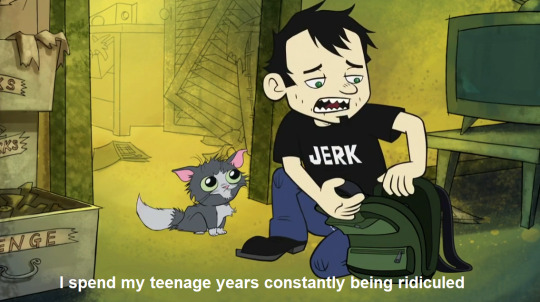
Nahhh you see, I'm not buying the episode's ending narrative of Dan always having been liked. Not with both Chris and Dan talking about them getting bullied/ridiculed. As someone who grew up with undiagnosed ADHD/Autism, my ignorance has always been exploited to be the butt of the joke. And I don't think the ending is any different from that. (strap in, it's a long one)
In this episode we learn Dan bullied Chris back then too, but we ALL know Dan is a very reactionary guy who acts largely on "setting things straight". It's not that outlandish to think Dan either acted his frustrations from getting bullied out on Chris OR Chris being caught in the crossfires of Dan getting back on someone.
And Chris honestly had it Terrible... Just look at how much he's been with his class and done for them, and how little they remember him.


Elise wants Chris to have a good time and reunite with old friends (to get rid of Dan), so when Dan shows up she locks him in a locker... And he responds like this:
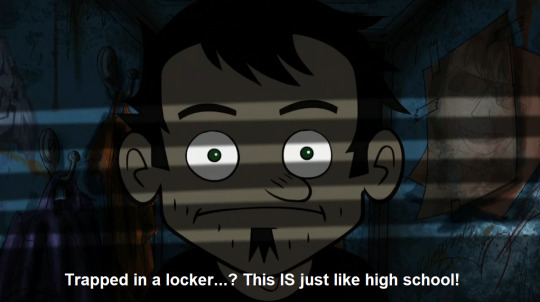
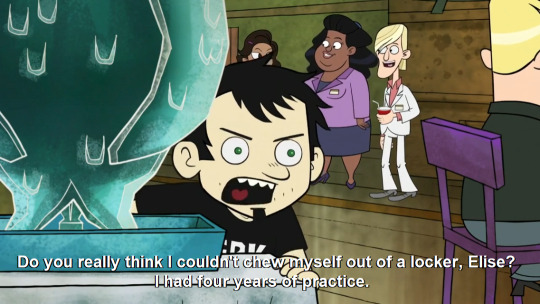
He's BEEN in those lockers before. His classmates PUT him there.
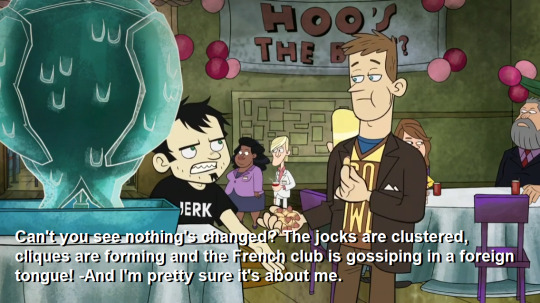
And he desperately wants Chris to see nothing's changed.

But Chris only remembers High School positively on his end... (even though he got wedgied too) So what gives?
It's because Chris stayed ignorant, but Dan didn't. Dan likely used to be just as ignorant as Chris, trusted people, and got hurt because of it. He learned not to trust people and to assume everyone's out to get him, because it's easier than getting humiliated or tricked, again. Chris never did! He always assumed it was just his friends goofing off, even though he got hurt in the process. And we can feel that in a later scene too.

Yes, Dan could be saying this because he genuinely thinks the costume is dumb, but if they both were getting bullied, Chris would very likely have been ridiculed for wearing it! So in his messed up Dan way, he DID try to save Chris, because HE'S learned to not trust any smiling faces.
Which is very apparent in the next scene, where he's strung up from the ceiling after he'd fallen.
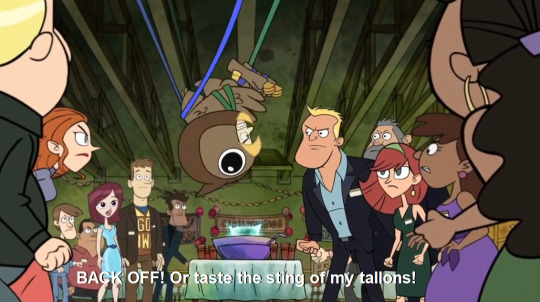
If you watch the episode, "BACK OFF" doesn't sound like his usual overly confident and aggressive tone. For a second, he sounds a bit frightened. He's constantly struggling to get out and doesn't say anything besides threatening people to leave him alone. People start listing all the ways he's taken revenge on them..... and then start cheering. Now, usually in a show like this, the main character would stop struggling and be baffled by the positive reception of his appearance.... but not Dan. He keeps warning people to stay away and keeps struggling.

People are laughing and cheering as they try to get him down, and he starts panicking. some tense music picks up as he flails, music usually used (in other cartoons too) when a character is in a scary situation.
He falls to the ground, looks up at everyone laughing


And runs. He doesn't try to fight anyone, he just runs.

And Elise and Chris respond with this:
"So your classmates actually LIKED Dan?"
"High school was somehow not as I remembered..."

So what happened here? Well, that's how they got bullied. That's how it started. And that's often how autistic people get bullied, too. They pretend to be nice to gain your trust, and then exploit that trust to belittle you, bully you and put you into humiliating situations. All while keeping up the "nice" act to make said autistic person doubt themself about whether or not the hurt they feel is warranted or not.
Chris isn't remembering High School wrong... Dan was right. They haven't changed. Even though they remember Dan fondly, he was never their friend. He was their play thing. Their personal jester to poke at and make fun of BECAUSE he reacted and lashed out. Chris never did, which is why he was never deemed "interesting" enough by his peers to be remembered.
Dan even says it himself in the scene after, trying to explain to Chris why it's all fake, but after all these years, Chris is still too ignorant to see it.





Dan is explaining to Chris as clearly as he can, how these people used and bullied them. They took advantage of their struggle to read social cues and used them both for entertainment.
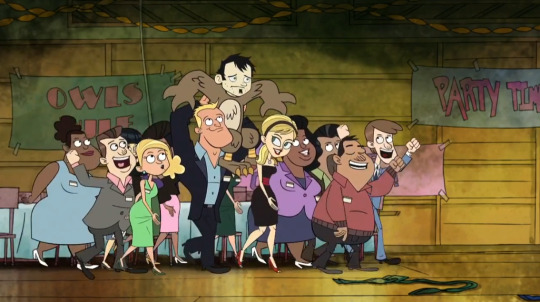
At the end of the day, they exploit Dan's struggles with social cues again to convince him they all genuinely liked him for who he is (conveniently leaving out all the times they pushed him in lockers)... While in reality, he was only ever good for bringing entertainment. What's even sadder, is that Chris envies him. He still can't see the full picture and wishes he could be in that spotlight.
Showing that ultimately it's not JUST the classmates that haven't changed, but Dan and Chris haven't either.
And it's another reason as to why they're still together after all these years. The only real friends they HAD were each other.
#dan vs#dan vs revival#dan vs chris#dan mandel#chris pearson#essay#analysis#dan vs analysis#cartoon analysis#dan vs high school reunion#episode analysis#bullying#long post
271 notes
·
View notes
Text
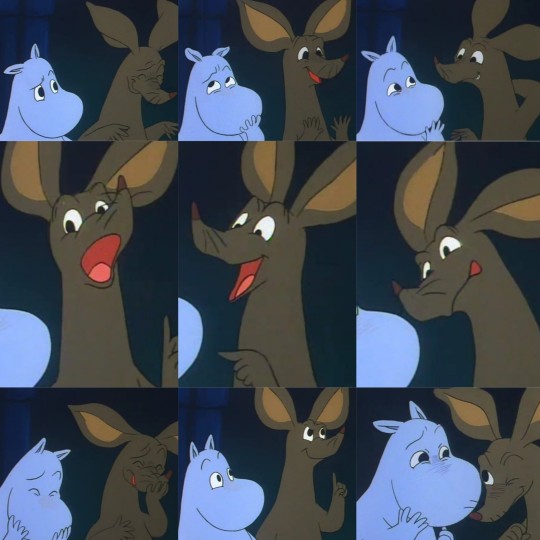



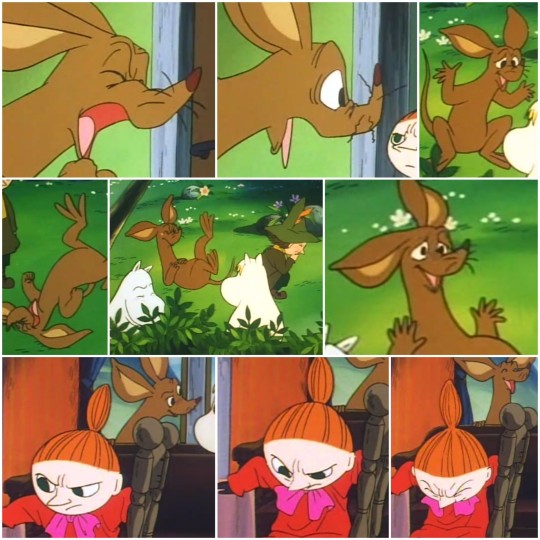

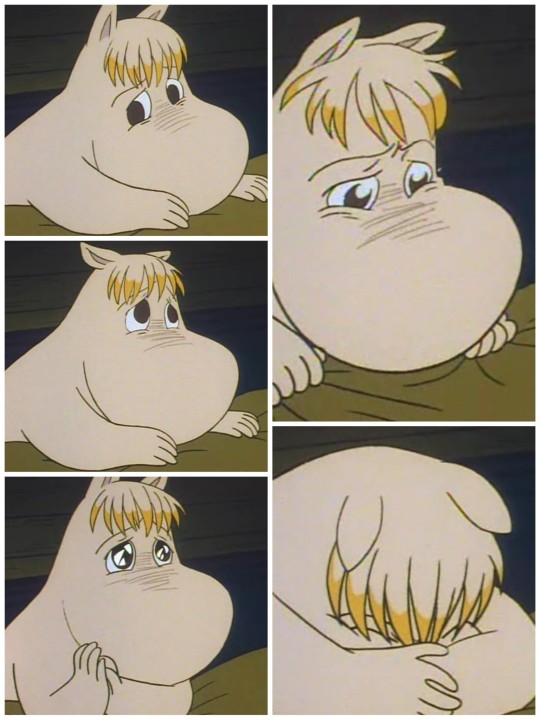
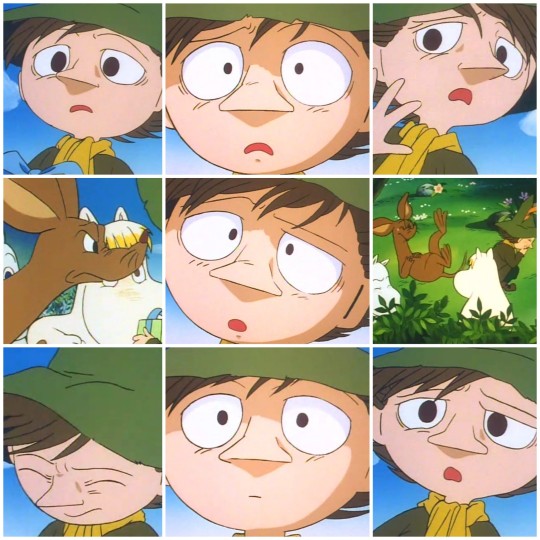
Some legitimately great expressions from episode 19 of Moomin: Adventure Diary; Hidden Love of Little My.
#moominvalley#moomin#moomins#moomin moments#90s season 2#tanoshii muumin ikka#90s moomin#moomin adventure diary#little my#moomin sniff#sniff moomin#snufkin#moomintroll#snorkmaiden#moomin screenshots#these are 66 different frames from the episode btw#dear booble these faces are great and so fun! It's nice seeing the artists take the time to push it as a cartoon#especially for something as low budget as an s2 episode#also yes I am deeply procrastinating on my MP's Memoirs essays by watching the entirety of this season#someone please help me#hidden love of little my
270 notes
·
View notes
Text
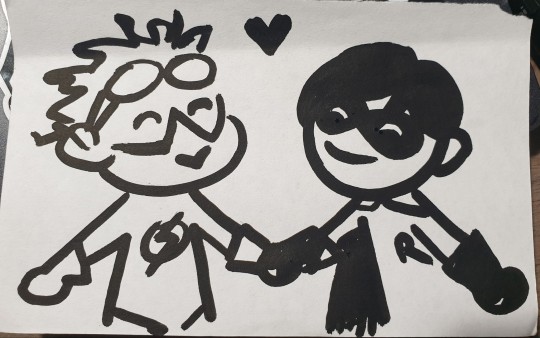
💖Them💖
#I'm supposed to write an 8 page essay for tomorrow morning and only 5 pages are done#but this is better#fanart#my art#traditional art#art#dick grayson#dc#robin#kid flash#Wally West#young justice#young justice cartoon#birdflash
61 notes
·
View notes
Text
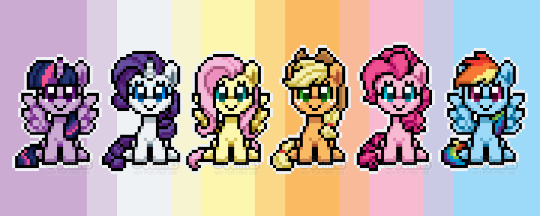
Thank you for being a friend 💖
I haven't done pixel art in ages, so I made these to celebrate the anniversary of my favorite show. Happy 13 years, Friendship is Magic!
#my art#pixel art#mlp#mlp fim#mlp g4#twilight sparkle#rarity#fluttershy#applejack#pinkie pie#rainbow dash#Shout out to the funny children's cartoon that accidentally changed the trajectory of my entire life lol#I could write entire essays about how much I love that show... but writing is hard! So I have a podcast instead! Listen to my podcast ;D
112 notes
·
View notes
Text
youtube
New video WAHOO!!!
47 notes
·
View notes
Text
The Bride and Ugly Ahh Groom meme, but Boxman is the bride and PV is the groom.
#voxman#ok ko#ive been thinking abt PV - the toxic bisexual ever - recently bc of sonic prime#i was like. oh yeah. Ok ko was inspired by the Sonic Saturday morning cartoon#... and then I started writing essays abt PV
23 notes
·
View notes
Text
And now, an essay about Dot Warner because I have nothing better to do
In the series bible for Animaniacs, Dot is described as:
"everything that all animated female characters have never been"
Was that true at the time?
I think so, and Here's Why
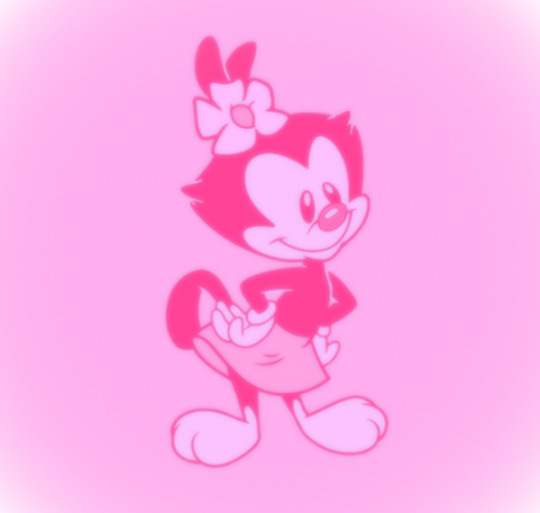
Before I begin, I'd like to mention this is mostly gonna revolve around western animation...and by "western" I mean "not anime". Okay? OK.
Part 1 : Her design
I'll start by comparing Dot's design to the design of many other female animal cartoon characters that came before her, because a lot of them are...not great. For context, Animaniacs (and therefore Dot herself) debuted in 1993. At the time (and after) when it came to animal cartoon characters, guys would often be designed as "the default" or "the norm", and girls would be given extra visual signifiers to make it clear that they are, in fact, girls. Stuff like human-like hair, and/or really long eyelashes, and/or human-like body parts such as hips and breasts so they needed to be fully clothed, and/or smaller noses and mouths than the guys to make them look "cuter", and/or permanent makeup, etc.
Let's take The Chipettes for example:

They barely look like chipmunks! They're basically human girls with chipmunk noses! Their-I guess it's probably fur-looks pale enough to pass as white skin, they have human lips, even human hair. Their hair doesn't even match their "fur" colour, which makes it look like skin even more. I know it's a cartoon, I don't expect them to resemble real chipmunks completely, but I should still be able to recognise them as chipmunks, shouldn't I? Just look at them compared to the boys, it's jarring:
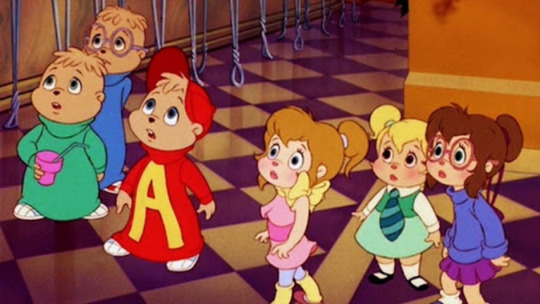
Although at least in their case, both the guys and girls are in full outfits rather than just the girls.
Gadget's probably another one of the best examples (pre-1993) of what I'm talking about (she has human hair and a more human-like body and hence needs a full outfit, meanwhile Chip and Dale do not), but Toodles is also a pretty good example (she has smaller, more human hands than Tom's, permanent makeup, really long eyelashes, and her figure even more human than Tom's). Even if they weren't in full outfits they usually were made to look more human:

Female animals were constantly given more human attributes than the guys, usually just to make them look "prettier". Honestly a lot of female animal characters are still designed this way.
Meanwhile guys can look as cartoony as possible and go around in half-complete outfits no problem, because they were drawn to be funny talking animals, not conventionally attractive human/animal hybrids:

Then in some cases they'd just take one of the pre-existing male characters, add a bow or skirt or eyelashes or something, and BOOM! A "new" character:

Yeah they have no human hair and have cartoony proportions, just like the guys...but they didn't have to make them look just like the guys to do that. I prefer these over the previous examples but...actually creative designs would be nice.
Now let's look at Dot:

See this? This is nice.
She has no human hair (the hair on her head is just more of her fur), no permanent makeup, no eyelashes needed to signify "she's the girl" (she's only drawn with eyelashes for comedic effect or when she's trying to look extra cute), no curves or hips, and isn't fully clothed and goes around with no shirt like Yakko, because she's a funny talking animal and should look like one, not a human girl.
Now let's compare her to her brothers:
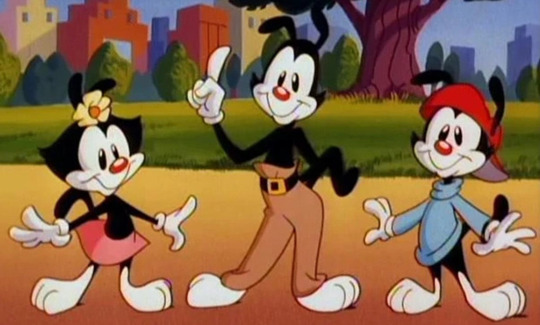
She's a different height, has no whiskers, a slightly different head shape, and has longer but not human-like hair. She looks similar enough to look related to them, but she's not just Yakko or Wakko in a skirt.
For this section I'm mostly just talking about animated animal characters, but I also want to mention that even with human characters male leads often were allowed to look round or blocky or basically any body type, and didn't have to look conventionally attractive; but female leads were almost never designed to look as cartoony, and were often drawn to look as conventionally attractive or cute as possible by being given more (even if just slightly) realistic proportions, and were usually of the same body type.

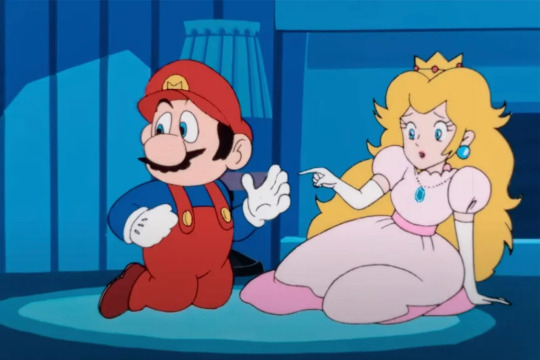
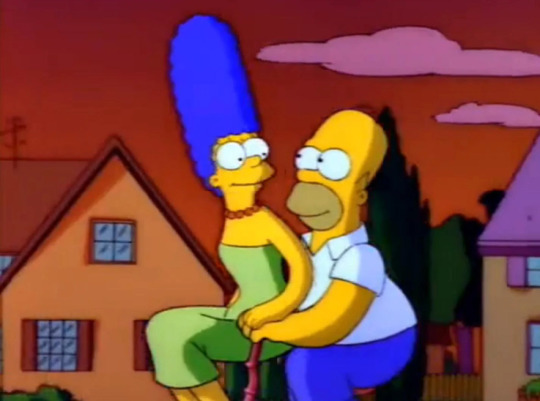
Now, the three human examples I showed aren't actually bad designs. Honestly, on their own, they're good designs! But they're once again showing that there was a clear difference regarding how guys were drawn vs how girls were drawn.
Dot's cute but they don't draw her anymore realistically than they do her brothers nor is her cuteness over-exaggerated by giving her more human attributes than necessary to make her as conventionally pretty as possible. She's anthropomorphic, but no more so than her brothers.
Part 2 : Her personality
Now, there were of female leads before Dot where the tropes I mentioned don't apply and whose designs are unique, like for example Olive Oyl, who's allowed to look wacky (stick thin and not curvy, lanky with noodle arms, circular head, large hands and feet) and Penelope Pussycat, who's allowed to look like an anthropomorphic, but still cartoony cat and not too human. So what I talked about before wasn't the case every time.

But then you have to consider their personalities (or sometimes, lack thereof).
Many animated female leads were flat characters compared to the male leads, often because they fell under cliché tropes.
Some of the most prominent being: the token love interest, the eye candy, the damsel in distress, or the sensible one because "girl", who would often mostly just exist to set up punchlines the male characters would deliver.
Of course this didn't apply to every animated female lead, especially not by the early 90's, but it was still the norm.
Even Babs Bunny, who predates and is similar to Dot whilst being a good character in her own right, falls under the token love interest trope (also her design is basically a pink Buster in bows, although in her case that was intentional given that their "No relation" catchphrase was meant to poke fun at the "male and female love interests look and are even named suspiciously similarly" trope, so for her it works). Basically in some cases they'd just staple these tropes onto decent characters who didn't really need them.
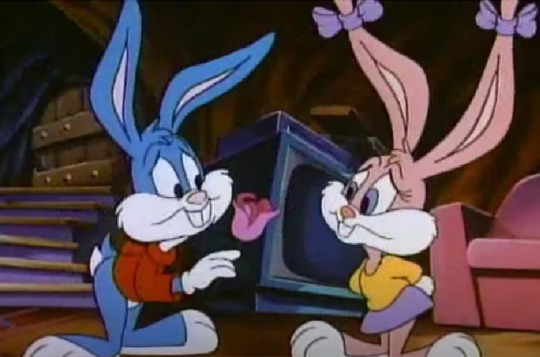
However, Dot doesn't fall under any of these categories. She's the younger sister so obviously she couldn't be a love interest, I just went over the fact that she wasn't designed to be eye candy, just cute but not in an over-exaggerated way, and she wasn't just cute to look appealing. Her cuteness benefited her character; either by the shock value of seeing a cute little girl swear or scare Satan or something like that, or by Dot using her cuteness fool foes (or at least make them look bad). She could hold her own in any situation and although both her and her brothers were captured a few times on the show, they escaped pretty easily each time. The one time she alone got kidnapped she basically saved herself, so I wouldn't count her as a damsel in distress because it never really feels like she's in real danger; the audience knows she's got this.
Most of all, she was definitely not the sensible one of the group. Sure she'd get annoyed when Yakko and Wakko did the Hello Nurse bit, but she was just as bad, and would react the same way whenever she came across a cute guy. She was of course written this way on purpose, she is very bit as wacky and silly and chaotic as her brothers. It didn't matter that she was the "cute one", she would go off-model if it meant she could make a funnier face. She'd gladly join in on tormenting their "special friends", without worrying about if their feelings got hurt or preaching that they should all try to get along. She'd gladly indulge in excessive violence. She'd gladly mess about and wreak havoc just as much as her brothers. I'm all for smart female characters (Dot is smart after all), but in a main group of guys and at least one girl, a girl doesn't have to be the sensible one every time.
It's no secret that Dot was written to be feminine. At the time, characters that were written to be very feminine often were written to fit within gender norms, meaning many were: passive, demure, soft-spoken, gentle, wide-eyed and innocent, and/or sensitive, etc; or at the very least more so than the masculine characters.
But Dot just wasn't any of those things. She was assertive, confident and acerbic, loud and outspoken, often acted more violent and angry then her brothers, witty, is as lustful and dirty-minded as her brothers, and doesn't get her feelings hurt easily and will instead pretend to be extremely upset/hurt for sympathy or for dramatic effect.
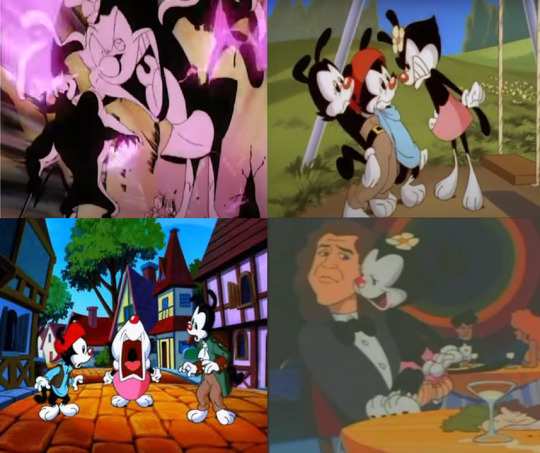
Before and around about the time of Dot's debut, if animated female leads were given personalities that broke many gender norms (and that already wasn't too common), they'd usually be tomboys. Now let me be clear, there is nothing wrong with tomboys. They're just as valid as girly girls and deserve to be and should be depicted in a positive light in animation, but this perpetuated the idea that to be tough and/or wacky, you had to be masculine, which just isn't true.
Dot was wacky and tough but still feminine and was by no means a tomboy, and I think that's important! She liked to look pretty, she liked pink and dresses and flowers, but she also made silly faces, liked to play rough and was more than willing to beat the living daylights out of someone who was asking for it.

Female characters in cartoons often either had decent personalities but their designs were lacklustre, or vice versa. Sometimes both their designs and personalities were lacklustre. Sometimes neither was a problem but their character was held back by having some trope forced onto them because "girl". Dot was a (at the time) rare case of none being the case whilst not having to sacrifice her femininity to be wild and strong.
Part 3 : Her role
By 1993, even if a female character had a good and unique design that didn't come with double standards and had a well-written personality that didn't submit to too many gender stereotypes, they were often:
A - An antagonist
I'm not saying these characters aren't bad people, but a lot of the time when we did get a fun female character, she was a villain.

Also (for this next point I'm not really talking about the three examples above), sometimes they were the only female characters in their show/movie/etc to go against gender stereotypes, which just perpetuates the idea that female characters breaking gender norms is wrong.
B - Essentially a clone of a male character
They'd act exactly like one of the male leads with minimal personality differences (those differences usually being more gender stereotypes) between the two, if there were any; again perpetuating the idea you had to be masculine to be wacky and/or tough.
Basically a distaff counterpart, or a half-identical twin, stuff like that.
C - Less important
Even when we did get a well-written, well designed female animated character who didn't fall under tropes associated with gender stereotypes, chances were she'd be a side character, or at the very least perceived as less important than the male leads.
I'll just use one example for this section since it's a lot more broad in terms of scope; Granny from Looney Tunes. She's one of the most well known female Looney Tunes characters, but even she was never really the "star" of the cartoons she was in. They're not called "Sylvester, Tweety, and Granny" cartoons, they're called "Sylvester and Tweety" cartoons. Even the show that was about Granny solving mysteries, what was it called?

But Dot doesn't fall under any of these categories. She's not a side character, she's not even a tritagonist, she's a protagonist. Yakko may have been the leader, but all the Warners acted as a unit and were presented as just important as each other. We call them "Yakko, Wakko and Dot", "The Warner Brothers, and the Warner Sister", etc.
I've already mentioned that's she's not designed as a clone of Yakko or Wakko, but she also had a distinct personality. She was more anger-prone than Yakko, she was wittier than Wakko, and she had a way bigger ego than both of them combined!
Dot's definitely not an antagonist, she wasn't a saint and she may have been chaotic, but you're meant to root for her. The people she and her brothers would go up against in their cartoons were often jerks, bullies, pompous, etc. Meanwhile the Warners had a strong sense of justice and morality. They weren't malicious (to people who didn't bother them at least), they just liked acting silly. When viewers saw Dot unapologetically being herself without conforming completely to how society thinks a cute little girl should act like, they weren't meant to hate her or love to hate her or anything like that, they were just meant to like her and laugh.
Part 4 : Today
There will probably always be room for improvement when it comes to female representation in cartoons, I mean, a lot of the tropes I mentioned are still commonly used (although I must stress that not all of them are inherently bad). However, it's better today than it was back then. We've gotten tons of well designed female leads over the past 30 years with three-dimensional personalities, ones who are gender non-conforming but still heroic, or who are strong but still feminine, or who are allowed to look and act as wacky as the guys on their show (if not more so), you get the idea.
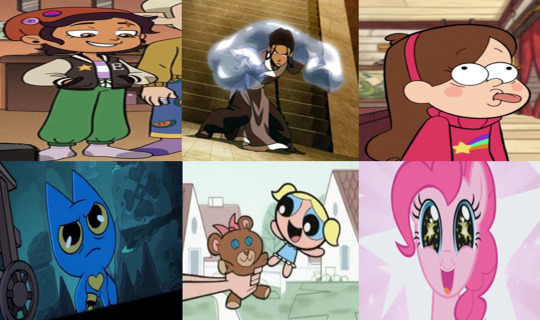
I'm not saying Dot is the first good animated female character (or that her character was handled perfectly in the original Animaniacs-it wasn't), we all know that's not true, but she defied many tropes that so many animated female characters before her fell under, through her design, personality AND role. Notice that a lot of other animated female leads that also do that (both the examples I gave and any extra ones that you can think of) most likely debuted after Dot did.
To be 100% honest, you could argue that, even as of 1993 (or I guess 1991 considering that's when the series bible was written), describing Dot as "everything that all animated female characters have never been" is debatable, but I do think there was some truth to that statement at the time. I can't say for sure that she was a trend setter when it came to how girls in cartoons were handled, but I'll always appreciate the fact that her character turned out the way it did in spite of when she was created.
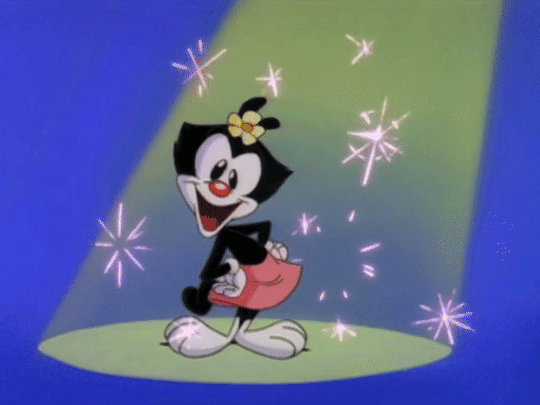
#animaniacs#dot warner#the warner sister#animation#cartoon#warner bros#wb#retro#classic cartoons#90's cartoons#90's tv#character design#essay#edit#princess angelina contessa louisa francesca banana fanna bo besca iii#no but seriously I unironically think Dot might be one of the most important female cartoon characters from the 90's#maybe even in general...or maybe I need to consume more media#I dunno I just wanted to gush about Dot 😅
142 notes
·
View notes
Text
Where are the teenage/YA cartoons?
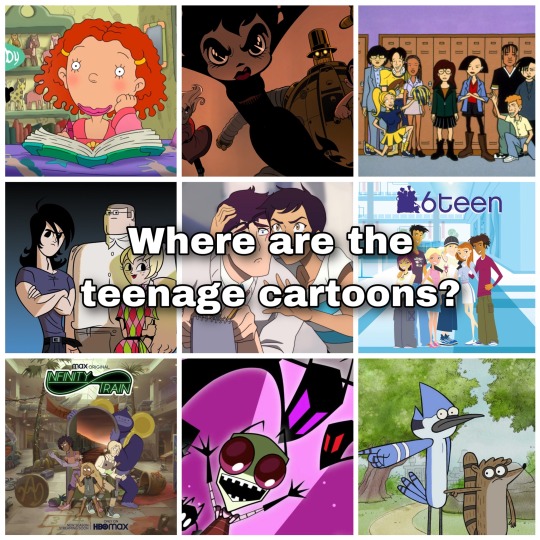
Recently, two cartoons that were slated to be on Cartoon Network, Unicorn: Warriors Eternal and My Adventures With Superman, are now going to be on Adult Swim.
To me, this move makes no sense. These shows could have diversified Cartoon Network’s very barebones lineup, but they were shoved to Adult Swim. I sorta understand Unicorn, as it is dark (but definitely not on the same level as Primal, one of Genndy Tartakovsky’s other shows), but My Adventures with Superman? That show seems pretty innocuous. It has a bright color palette and doesn’t seem similar to Harley Quinn or the later seasons of Young Justice.
This reminds me of the desperate need there is for teen/YA-oriented western cartoons. In western animation, there are three primary audiences:
Preschoolers; anything rated TV-Y, shown on PBS Kids, Nick Jr, Disney Junior, or Cartoonito. Example: Doc McStuffins.
Big kids/elementary school crowd; anything rated TV-Y7, can be seen on Nickelodeon, Cartoon Network, and Disney Channel. Example: The Amazing World of Gumball.
Adult; anything rated TV-14 or TV-MA, seen on Adult Swim, Comedy Central, or the prime time Fox lineup. Example: Rick and Morty.
That’s it. Despite what the rating of TV-14 might lead you to believe, the stuff on Animation Domination or Adult Swim isn’t targeted to teenagers, obviously.
This leaves teenagers in a weird spot when it comes to watching cartoons (western ones, that is. They definitely watch anime). They tend to stick with big kids and/or adult cartoons, like Avatar. With all of the heavy subject matter it and Korra tackle, they definitely feel more like teenage cartoons, especially since they were inspired by anime.
I bring up anime because they have clearly defined demographics, including teenagers. They have manga/anime for teenage boys, shonen (Naruto, One Piece, Dragon Ball Z), and teenage girls, shojo (Fruits Basket, Kamisama Kiss, Yona of the Dawn).
Shojo anime (except Sailor Moon) pretty much never air on American TV, but when shonen anime are exported here, they end up on Adult Swim’s Toonami block. For example, Demon Slayer aired on Toonami (they had to stop airing it because it got too expensive), and in America, the Mugen Train movie was rated R. This despite Demon Slayer being aimed at teenagers, and also being enjoyed by small children in Japan. They even had a Japanese Happy Meal promotion that ran alongside Pretty Cure, a show that actually is aimed at small children (kodomomuke).
With America’s teenagers flocking to anime, I believe that the American animation industry should keep up with the times and try to capitalize on the teenage demographic instead of shoehorning shows to be for elementary schoolers or adults.
Here are some western cartoons I believe could be classified as YA/teenage shows:
Avatar and Korra, as mentioned above.
Most cartoons aired on MTV, such as Daria, Beavis and Butthead, and Clone High. It helps that MTV itself was aimed at teenagers. Aeon Flux is an exception however, as it is clearly for adults. They’re often shoehorned into the category of “adult animation,” but their subject matter is more appealing to teens.
6teen. It’s right there in the title! Canada knows what’s up.
Total Drama, another Canadian cartoon. I know that they made the younger-skewing DramaRama spin-off because teenagers weren’t watching cartoons anymore, but now that the main show is coming back, it will definitely be aimed at teenagers again.
Sym Bionic Titan, yet another Tartakovsky show, pretty much is a teen/YA show, minus swearing. If I remember correctly, it aired on Toonami for a little while.
Regular Show. The most obvious example of a YA cartoon disguised as a kids cartoon.
Infinity Train. Never forget that it was cancelled because “no child entry point.”
As Told By Ginger is essentially a teen drama in animated form.
Invader Zim - Nickelodeon asked Johnson Vasquez to make a show directed towards older audiences, got exactly what they wanted (most of the viewership was from teens and adults, especially of the shops-at-Hot Topic variety) and cancelled it anyway.
Arcane is technically an adult series, but League of Legends is rated T by the ESRB, so I’m putting it in the teen/YA category (there IS a distinction between ‘young adult’ and ‘adult’)
I highly doubt that the likes of Nickelodeon will add a teenage animation block to their lineup (and TeenNick is nothing but iCarly reruns), but I hope that streaming services will start capitalizing on the YA demographic for western animation. Bee and Puppycat is a good start, featuring relatable young adult situations while technically being watchable for all ages. At least Unicorn is gonna air on ACME Night, which isn’t too late in the evening (currently, the block starts at 5:30 EST). And with Clone High and the aforementioned Total Drama making a comeback, I’m holding out hope for more YA animation.
#long post#animation#western animation#cartoons#ya#my adventures with Superman#unicorn warriors eternal#adult swim#Toonami#6teen#daria#infinity train#as told by ginger#acme night#my animation essays
537 notes
·
View notes
Text
my kids are watching pocoyo, and yours should too.
note: i don't have kids; the headline is merely an expression.
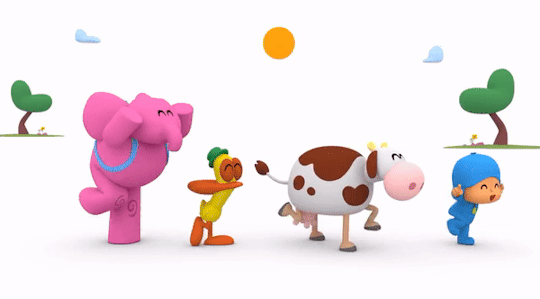
so, as someone who is very passionate about art, i try to hold back from critiquing artworks solely based on personal preference...
that being said, i really like minimalism; the concept of achieving something grand with minimal resources captivates me, and pocoyo, in its ambitious yet lighthearted approach, successfully embraces this artistic philosophy in a way that is both interesting and groundbreaking.
in contrast to the prevalent corporate memphis seen in various enterprises' branding, pocoyo distinguishes itself by avoiding the trappings of a simplifying obsession meant to dumb down iconography.
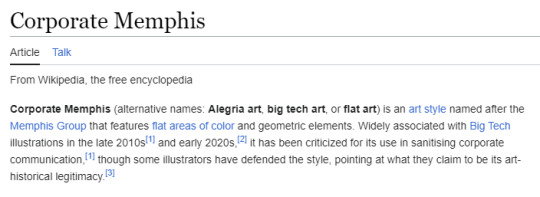
this contemporary minimalist art style is not inherently bad—i personally find it relatively pleasant when used right— but its proliferation often acts as a visually unobtrusive background for corporate spaces. this is like the muzak of visual arts.
for those who don't know, is what we often call elevator music—fabricated to create a facade of a calm work environment for low-income workers, masking the exploitation they endure.
pocoyo utilizes minimalism with another purpose. it invites viewers to immerse themselves in the simplicity of its visuals, employing limited objects that encourage the mind to actively participate by "filling in the blanks."

the cartoon unfolds on an all-white canvas with only certain characters and key items strategically placed, creating ample negative space.
the intentional use of negative space allows the viewer to focus on the characters and the story without unnecessary distractions. the storytelling approach in pocoyo resonates with performative theatre, where negative space is abundant, engaging the audience by encouraging them to fill it with their interpretations; it keeps the viewer at the edge of their seat trying to fill that negative space, if not with items, with an ambientation and abstract elements.
in an era saturated with mindless maximalism and visual oversaturation in media targeted to children, pocoyo stands out by embracing responsible minimalism.
this approach contrasts sharply with the likes of youtube content-farms and cocomelon, a cartoon exemplifying this aggressive maximalism i'm talking about.
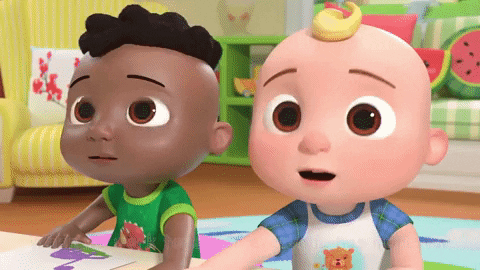
cocomelon's rapid scene cuts every 2 to 4 seconds contribute to overstimulation and potential addiction in young viewers.
they're putting our children on crack.
in contrast, pocoyo's deliberate pacing, occasionally featuring tracking shots and long takes, challenges and improves attention spans.
furthermore, pocoyo employs a narrating language akin to normal adult conversation, fostering a healthy communication style. this stands in stark contrast to cocomelon's patronizing approach and zombie ass nursery rhymes, which oversimplifies language and undermines the development of critical thinking and abstract appreciation in young minds.
so, in conclusion, pocoyo's nuanced approach to minimalism and storytelling not only sets it apart in the world of animated content nowadays, but also challenges the prevailing trends that prioritize overstimulation over depth. it stands as a testament to the potential of thoughtful, intentional design in captivating and educating audiences of all ages.
i love it so much.
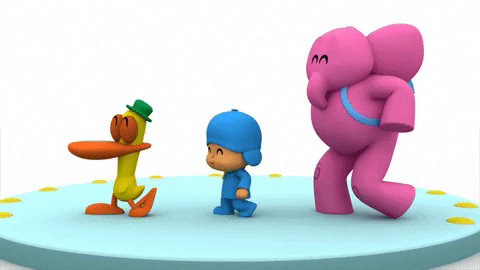
#ramble tag#ramblings#rant#mini essay#hear me out#i swear#you dont get it#i am right#pocoyo#children mental health#childrens media#ipad kids#parenting#it is that deep#minimalism#cocomelon#cocomelon shit#does this make sense#i wrote this in one go#cartoons#youtube#content farm#i am cringe but i am free#they hated jesus because he spoke the truth#corporate memphis#muzak#im going insane
41 notes
·
View notes